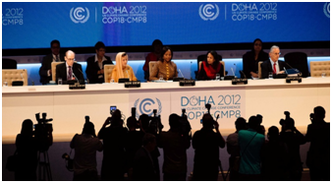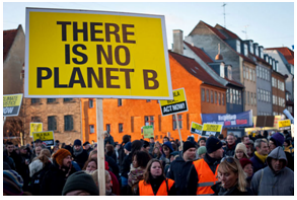The COPs

Did you say COP?
You have heard of the Kyoto Protocol, conferences in Copenhagen and Doha ... Maybe you have heard the word "COP" once in a while. What is it all about?
In 1992, during the Rio Earth Summit, the United Nations Framework Convention on Climate Change (UNFCCC) was established. In international law, a convention is like a contract between "parties" (states), which sets a number of rules and objectives. One of the rules was the decision to organize international conferences every year gathering all parties (currently, 196 states) in order to talk about climate change. These conferences are called Conferences of Parties (or COPs). Since the establishment of COPs, all parties have met annually to negotiate the reduction of GHG gas levels in the atmosphere. Representatives of non-state actors in society (governmental and non-governmental organizations, local authorities, trade unions, business, scientific, youth) are also invited to participate in these international conferences.
Photograph: COP18 / CMP8 in Doha (Qatar) (©LWF Youth)
You have heard of the Kyoto Protocol, conferences in Copenhagen and Doha ... Maybe you have heard the word "COP" once in a while. What is it all about?
In 1992, during the Rio Earth Summit, the United Nations Framework Convention on Climate Change (UNFCCC) was established. In international law, a convention is like a contract between "parties" (states), which sets a number of rules and objectives. One of the rules was the decision to organize international conferences every year gathering all parties (currently, 196 states) in order to talk about climate change. These conferences are called Conferences of Parties (or COPs). Since the establishment of COPs, all parties have met annually to negotiate the reduction of GHG gas levels in the atmosphere. Representatives of non-state actors in society (governmental and non-governmental organizations, local authorities, trade unions, business, scientific, youth) are also invited to participate in these international conferences.
Photograph: COP18 / CMP8 in Doha (Qatar) (©LWF Youth)

All you should know about the COPs in 50 seconds!
Photograph: Mobilization for COP15 / CMP5 in Copenhagen (©Mathias Vejerslev)
Photograph: Mobilization for COP15 / CMP5 in Copenhagen (©Mathias Vejerslev)
- 1992: At the Earth Summit in Rio (Brazil), 192 countries signed the United Nations Framework Convention on Climate Change (UNFCCC) and decided to stabilize their emissions of greenhouse gases by 2012. They agreed to hold an annual conference, which would be called "Conference of the Parties" (COP) to decide on the practical implementation of the Convention.
- 1995: The first COP was held in Berlin (Germany).
- 1997: The COP 3 took place in Kyoto (Japan). This conference gave birth to the Kyoto Protocol which introduced binding targets for most industrialized countries. It entered into force in 2005, was completed in 2012 and was not signed by the 192 signatories of the UNFCCC.
- 2009: COP15 Copenhagen (Netherlands) ended with the adoption of a non-legally binding instrument, developed by the United States and four emerging countries (China, Brazil, India and South Africa). It affirmed the need to limit global warming to 2°C compared to the pre-industrial era, but had no concrete commitment to reduce greenhouse gas emissions.
- 2010: COP16, held in Cancun (Mexico), adopted a text introducing a series of mechanisms to fight against climate change, including a Green Climate Fund to financially help developing countries to adapt to climate change.
- 2011: COP17, held in Durban (South Africa), saw the adoption of a roadmap to achieve by 2015 a global agreement to reduce greenhouse gas emissions, whose entry implementation is scheduled for 2020. Negotiations especially blocked on the principle of "Common but Differentiated Responsibility" (CBDR), giving each country a target to reduce emissions according to its estimated impact on climate change and current emissions.
- 2012: COP18 held in Doha (Qatar) in December 2012 saw the adoption of a second commitment period of the Kyoto Protocol to reduce greenhouse gas emissions and limit the temperature rise to 2°C. This commitment applies only to the European Union and a dozen other countries. Russia, Canada, New Zealand and Japan did not volunteer for this second trial and the United States, which had not ratified the Kyoto Protocol, were not affected.
- 2013: COP19 held in Warsaw (Poland) in November 2013 saw the adoption of the Warsaw International Mechanism for Loss and Damage associated with long-term climate change impacts in developing countries. Furthermore, governments agreed to identify how they will be working to reach their commitment to reduce their Greenhouse gas emissions by the beginning of the COP20 in Lima. Two main objectives were set for the COP21 in Paris in 2015: compel nations in a global effort to reduce pollution causing climate change while working on climate change adaptation and promoting the rapid and global actions.
- 2014: COP20 was held in Lima (Peru) from 1st to 12nd December 2013. The aim was to draw the draft of the COP21's negotiations which would lead to a concrete and binding commitment to address the impacts of climate change. The conclusions must respect the common but differentiated responsibilities' principle. Other important issues as adaptation to climate change was discussed.
- 2015: COP21 in Paris : The 21st Conference of the Parties ended with the adoption of a new climate agreement, described by many as a “landmark” agreement, and a “milestone” in climate policy. It is a universal text, binding under international law. It aims at holding the increase in the temperatures well below 2°C and if possible at 1.5°C above pre-industrial levels. It has also an objective of redirecting finance flows towards decarbonization and climate-resilient development. In addition to the agreement, the vast majority of UNFCCC parties submitted Intended Nationally Determined Contributions (INDCs), which outline the national plans of countries regarding their climate actions.
- 2016: COP22 in Marrakesh. The Paris agreement is expected to enter into force in 2016, once 55 parties of the UNFCCC, representing at least 55% of global GHG emissions, ratify it. In Marrakesh, Parties are expected to discuss the implementation of the Paris agreement.

